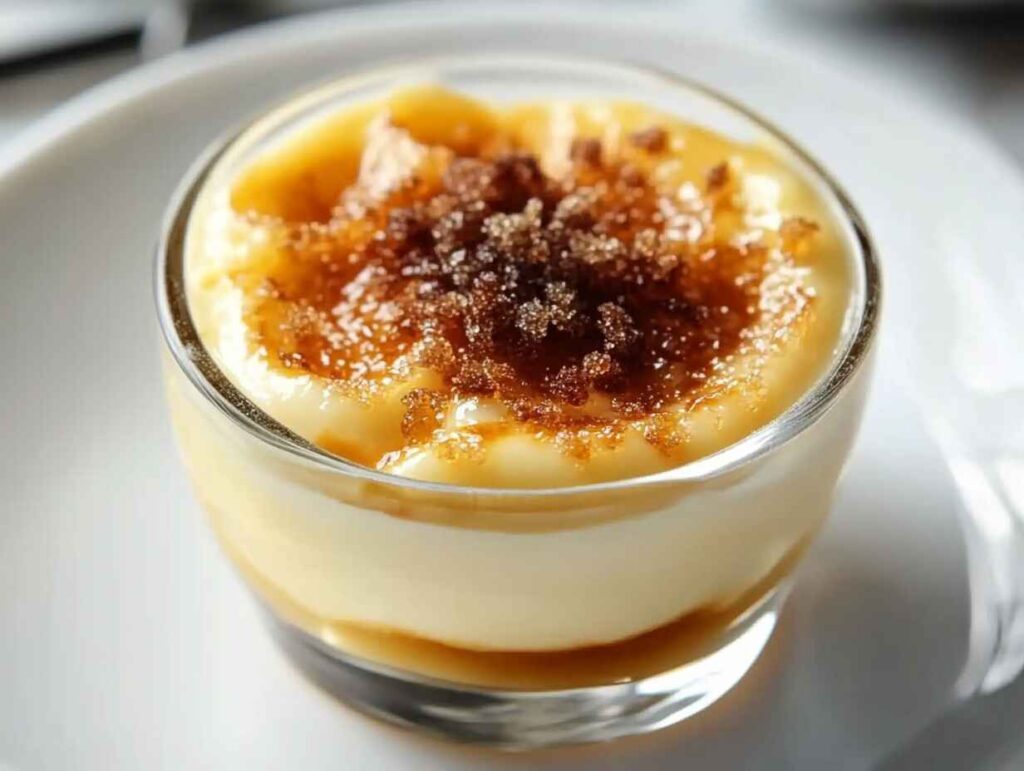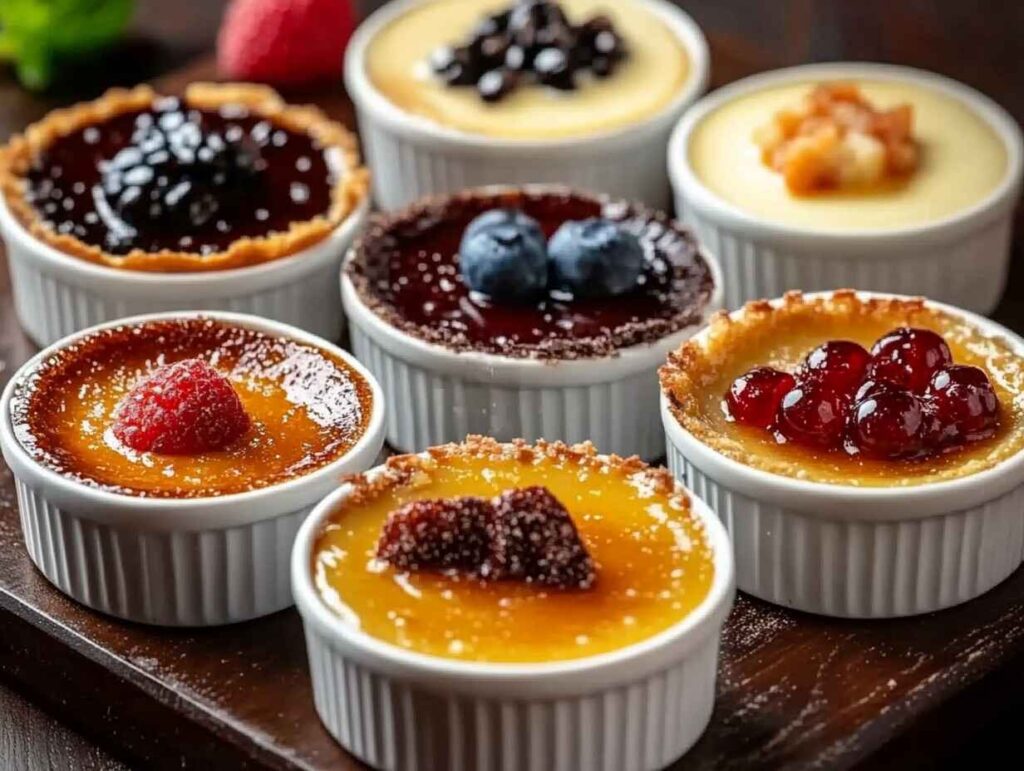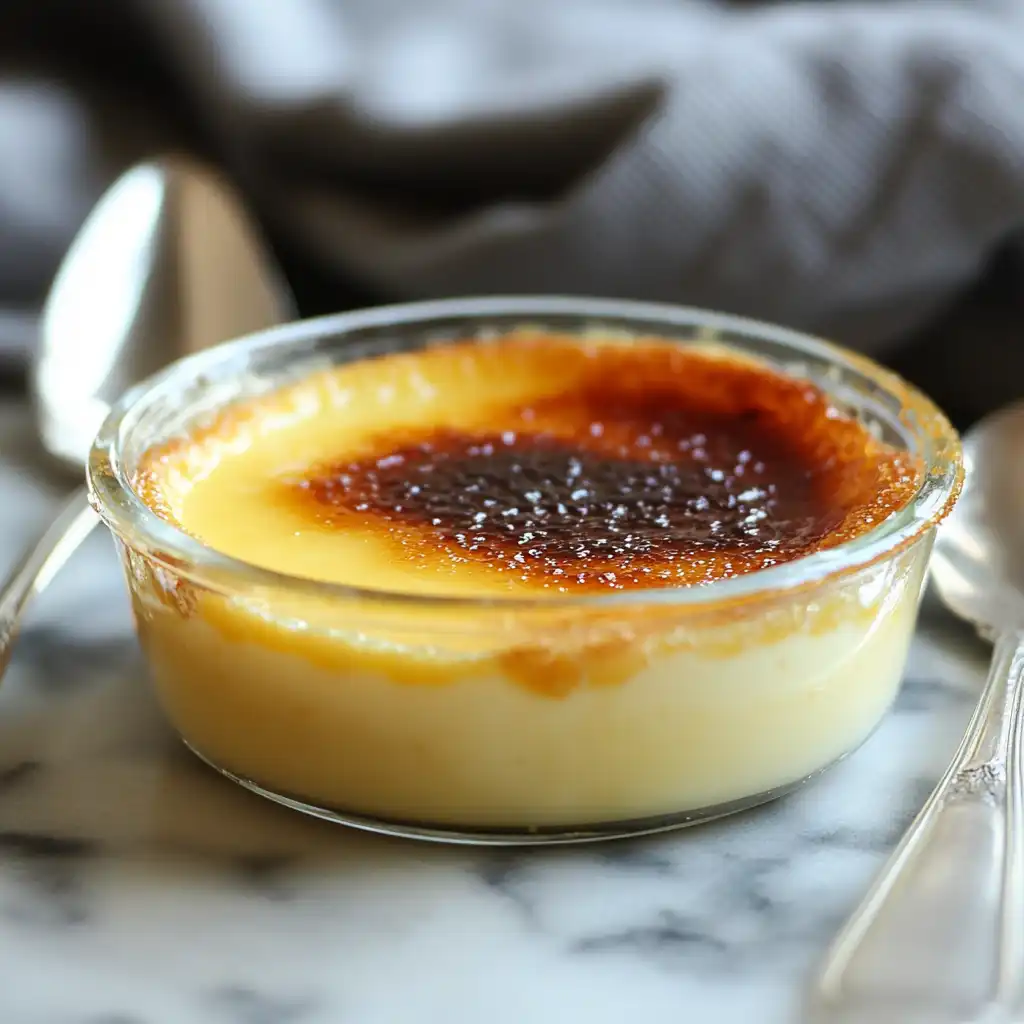Crème brûlée is one of the most iconic desserts in the culinary world, celebrated for its luxurious texture and unforgettable flavor. With its rich custard base and brittle caramelized sugar topping, this French classic offers a delightful interplay of sweetness and subtle bitterness. But what exactly does crème brûlée taste like?
The answer lies in the intricate balance of creamy vanilla flavors, a whisper of caramelized sugar, and the textural contrast between smooth custard and a crunchy crust. From its first spoonful to the last, crème brûlée delivers an indulgent experience that satisfies both the palate and the senses. If you’re curious about how crème brûlée is made, check out our detailed guide on what crème brûlée is made of.
Table of Contents
What is Crème Brûlée?
Crème brûlée, which translates to “burnt cream” in French, stands out as a sophisticated dessert with a history deeply rooted in European culinary tradition. This delicacy showcases elegant simplicity by transforming a few basic ingredients into a luxurious and comforting treat.
Origins of Crème Brûlée
Historians continue to debate the origins of crème brûlée, as France, England, and Spain all lay claim to its creation. While the French term undoubtedly helped popularize the dish worldwide, early variations, such as England’s ‘burnt cream’ or Spain’s ‘Crema Catalana,’ also display similar characteristics. Nevertheless, despite its contested origins, crème brûlée has undeniably established itself as a dessert that symbolizes both fine dining and indulgence.
Basic Composition
At its core, crème brûlée consists of the following essential ingredients:
- Cream: Heavy cream forms the base, lending the dessert its signature richness.
- Egg Yolks: These provide structure and help create the silky, custard-like texture.
- Sugar: Used in the custard and as a topping for caramelization.
- Vanilla: The classic flavoring, adding warmth and aroma.
The custard is prepared by gently cooking the cream and mixing it with the egg yolks and sugar. Once the mixture is poured into ramekins, it is baked in a water bath to achieve its smooth, creamy consistency. After chilling, the surface is sprinkled with sugar and torched to form the iconic caramelized crust.
Signature Elements
- Custard Base: Smooth, creamy, and lightly sweetened, with a rich mouthfeel.
- Caramelized Sugar Topping: A thin, crisp layer with a bittersweet flavor that complements the custard.
This perfect balance of flavors and textures is what makes crème brûlée so extraordinary.

The Flavor Profile of Crème Brûlée
The taste of crème brûlée is a perfect harmony of rich, creamy sweetness and subtle caramel bitterness. Its flavors are understated yet indulgent, making it a dessert that appeals to a wide range of palates. Let’s break down the key components of its flavor profile.
1. The Creamy Custard Base
The custard is velvety smooth, with a delicate sweetness and notes of aromatic vanilla. Its luxurious texture makes every bite feel like a moment of indulgence. Learn how to achieve a similar custard base with tips from our comparison of crème brûlée and custard.
- Richness: The cream provides a luxurious mouthfeel, making each bite feel satisfying.
- Delicate Sweetness: The sugar in the custard is carefully balanced to avoid cloying sweetness, allowing the other flavors to shine.
- Vanilla Notes: Traditional crème brûlée is infused with vanilla, lending a warm, aromatic flavor that adds depth and sophistication to the custard.
2. The Caramelized Sugar Topping
The top layer is a crisp caramel shell that cracks delightfully under your spoon. Its bittersweet flavor complements the creamy custard perfectly. Wondering how to master this topping? Explore our tips on how to caramelize crème brûlée.
- Bittersweet Flavor: As the sugar caramelizes under high heat, it develops a slightly burnt, toasty flavor that enhances the dessert’s complexity.
- Crunchy Texture: The hardened sugar forms a crisp layer that cracks under your spoon, creating a satisfying crunch with every bite.
3. The Perfect Balance
What sets crème brûlée apart from other desserts is its balance. The richness of the custard is offset by the bittersweet caramel, creating a taste that is indulgent but never heavy. This balance makes it an ideal finish to any meal, from a casual dinner to a fine dining experience.
4. Subtle Aromas and Aftertaste
Crème brûlée’s flavors linger pleasantly on the palate, leaving a creamy, lightly sweetened aftertaste with hints of vanilla and caramel. The subtlety of these flavors makes the dessert feel both luxurious and understated, a hallmark of its enduring popularity.
The Textural Experience of Crème Brûlée
Crème brûlée isn’t just about flavor it’s a dessert that engages multiple senses. The combination of silky custard and crunchy caramelized sugar creates a dynamic eating experience. Learn more about unique recipes like crab brûlée that put a savory twist on this classic dessert.
1. The Silky Custard
The base of crème brûlée is a creamy, custard-like layer that melts in your mouth.
- Smooth and Velvety: The custard is cooked slowly in a water bath to ensure a silky, lump-free texture. Each spoonful glides effortlessly on the tongue.
- Light and Airy Yet Decadent: Although rich in flavor, the custard has a light and fluffy consistency that keeps it from feeling overly heavy.
2. The Crisp Caramelized Sugar Topping
The top layer of crème brûlée provides a stark contrast to the softness of the custard.
- Crunch Factor: When torched, the sugar forms a brittle shell that cracks audibly as you dig in with a spoon. This satisfying crunch is a signature characteristic of crème brûlée.
- Thin Yet Sturdy: The caramel layer is thin enough to be delicate but sturdy enough to provide a satisfying textural contrast.
3. The Contrast Between Layers
The true magic of crème brûlée lies in the combination of these two textures. The brittle caramel breaks into shards that blend with the creamy custard, creating a mouthfeel that is both dynamic and indulgent. This duality elevates the dessert, making it a sensory delight.
4. How the Texture Enhances Flavor
Texture plays an important role in how flavors are perceived. The crunch of the sugar enhances the caramel’s bittersweet notes, while the creamy custard amplifies the vanilla’s richness. Together, they create a multi-sensory experience that feels both satisfying and elegant.
5. The Joy of Breaking the Sugar Crust
One of the most enjoyable aspects of crème brûlée is the act of cracking the caramelized sugar with a spoon. It’s a small but delightful ritual that adds an interactive element to the dessert, making it not just a treat for the palate but an experience for the senses.
Common Variations in the Taste of Crème Brûlée
While the classic vanilla crème brûlée remains the gold standard, chefs and home cooks worldwide have put their creative spins on this dessert, introducing flavors that complement its rich custard and caramelized topping. These variations can take the dessert in exciting new directions, appealing to diverse palates.
1. Chocolate Crème Brûlée
Chocolate lovers enjoy this variation for its deeper, more indulgent flavor.
- Flavor Profile: The addition of cocoa or melted dark chocolate to the custard base creates a richer, slightly bittersweet taste.
- Texture: While the custard remains creamy, the chocolate adds a denser mouthfeel.
- Pairing: Perfect with a topping of caramelized sugar, which balances the bitterness of the chocolate.
2. Coffee or Espresso Crème Brûlée
For fans of bold flavors, coffee-infused crème brûlée is an excellent choice.
- Flavor Profile: Coffee or espresso introduces a robust, slightly bitter edge that contrasts beautifully with the dessert’s sweetness.
- Aromatic Appeal: The aroma of coffee enhances the sensory experience, making this variation both fragrant and flavorful.
3. Citrus Variations
Citrus flavors like orange, lemon, or lime add a zesty twist to the classic dessert.
- Flavor Profile: Citrus zest or extracts provide a refreshing tang that brightens the custard’s richness.
- Balance: The tartness cuts through the creamy base, adding a lively dimension to the dessert.
4. Spiced Crème Brûlée
Warm spices can elevate the taste of crème brûlée, especially during colder months.
- Popular Spices: Cinnamon, nutmeg, cardamom, and cloves add warmth and depth.
- Seasonal Appeal: These flavors are often associated with holiday desserts, making spiced crème brûlée a festive treat.
5. Fruit-Flavored Crème Brûlée
Fresh fruit and purees can provide a natural sweetness and vibrant flavor.
- Berries: Blueberries, raspberries, or strawberries can be blended into the custard or served as toppings.
- Exotic Fruits: Mango, passion fruit, or coconut offer tropical variations for adventurous palates.
6. Vegan and Dairy-Free Crème Brûlée
For those with dietary restrictions, alternative ingredients can replicate the flavors and textures of traditional crème brûlée.
- Ingredients: Coconut milk, almond milk, or cashew cream replace heavy cream, while plant-based thickeners like agar-agar substitute egg yolks.
- Flavor Profile: These versions retain the creamy base but introduce subtle nutty or coconut notes.
Why Variations Are Popular
These creative adaptations ensure that crème brûlée remains versatile and exciting while still preserving its essence. Whether you prefer the classic vanilla version or an inventive twist, crème brûlée offers a flavor for everyone.

Why Crème Brûlée is Beloved and How to Pair It
Its universal appeal undoubtedly lies in its elegance and versatility. Moreover, from fine dining to home kitchens, crème brûlée is cherished for its remarkable ability to be both sophisticated and comforting. Whether you prefer the traditional vanilla version or, alternatively, enjoy experimenting with creative variations, it’s a dessert that consistently manages to impress.
For a deeper dive into the history and techniques behind crème brûlée, read about the difference between crème brûlée and custard or explore the best methods for caramelizing the sugar topping.
1. Elegance and Sophistication
Crème brûlée is often associated with fine dining due to its luxurious presentation and intricate preparation.
- A Showstopper Dessert: The golden caramelized crust and creamy custard are visually appealing, adding a touch of sophistication to any meal.
- Timeless Appeal: Its roots in European culinary traditions give it a sense of heritage and prestige.
2. Comfort and Indulgence
Despite its elegance, crème brûlée is also deeply comforting.
- Familiar flavors like vanilla, cream, and caramel evoke a sense of warmth and nostalgia and are universally loved
- Customizable Experience: Whether enjoyed plain or with added flavors, crème brûlée feels indulgent and satisfying.
3. Versatility in Pairings
Crème brûlée’s mild sweetness and balanced flavor make it a versatile dessert that pairs beautifully with a variety of beverages and accompaniments.
a. Beverages
- Coffee or Espresso: The bitterness of coffee enhances the dessert’s caramel notes.
- Tea: Delicate herbal or floral teas like chamomile or jasmine offer a light pairing that doesn’t overwhelm the dessert.
b. Fruits and Garnishes
- Fresh Berries: Strawberries, raspberries, or blueberries provide a tangy contrast to the custard’s creaminess.
- Candied Nuts: Add crunch and a nutty flavor to enhance the texture.
- Edible Flowers: Use flowers like lavender or violets for a decorative and aromatic touch.
4. Popularity Across Cultures
Though crème brûlée originated in France, people worldwide have embraced it for its adaptability.. From American restaurants to Asian fusion cuisine, it has become a staple on dessert menus globally, with each region adding its unique twist.
5. The Sensory Pleasure of Crème Brûlée
The act of eating crème brûlée is an experience in itself:
- The audible crack of the sugar crust.
- The smooth, creamy custard melting in your mouth.
- The lingering notes of vanilla and caramel.
This combination of sensory delights explains why crème brûlée is a perennial favorite among dessert lovers.
Conclusion
Without a doubt, crème brûlée offers a culinary experience unlike any other. Not only does it feature rich flavors, but it also captivates with contrasting textures, which together create a dessert that consistently leaves a lasting impression. Furthermore, whether you’re savoring a classic recipe or, conversely, exploring innovative variations, crème brûlée continues to remain a timeless treat that never goes out of style.
For more dessert inspiration, check out our collection of sweet breakfast recipes and start your day with a touch of indulgence.

